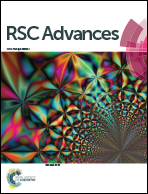Fabrication and photocatalytic performances of BiOCl nanosheets modified with ultrafine Bi2O3 nanocrystals
Abstract
BiOCl nanosheets modified with ultrafine Bi2O3 nanocrystals were synthesized by chemical deposition with the assistance of ascorbic acid and Pluronic F127. The structure, morphology, elemental composition and optical absorption performance were characterized using X-ray diffractometry, scanning electron microscopy, high-resolution transmission electron microscopy, X-ray photoelectron spectroscopy and UV-vis diffuse reflection spectroscopy, respectively. Square-like BiOCl nanosheets with ultrafine Bi2O3 nanocrystals evenly distributed on the surface were obtained. The photocatalytic activity of the composite was tested by degrading a 40 mg L−1 methyl orange solution under UV light illumination. A Bi2O3/BiOCl composite prepared with a Bi(NO3)3 concentration of 0.01 M achieved the highest photocatalytic rate of 100% in 6 min under UV light illumination. Repeated experiments on the degradation processes and recycling experiments on the photocatalysts were conducted under the same conditions. The results show that the as-synthesized Bi2O3/BiOCl composites possess excellent photocatalytic activity and outstanding recyclability. The photocatalytic mechanism of the composite is discussed.


 Please wait while we load your content...
Please wait while we load your content...